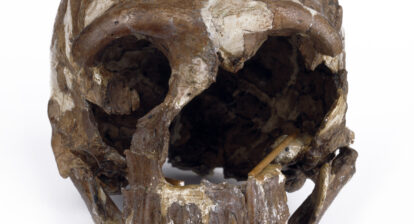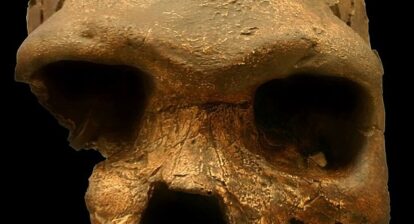In June 2022, a team of researchers observed a behavior never before witnessed in the animal world: A Sumatran orangutan named Rakus self-treated an injury using a medicinal plant.
At Gunung Leuser National Park, a rainforest reserve on the western Indonesian island of Sumatra, scientists heard from the treetops a series of “long calls,” a behavior that usually preempts assertions of male dominance or aggression. The next day, they saw Rakus with an open wound on his right cheek, just below his eye.
Days later, the team watched Rakus get to work—picking and chewing the stems and leaves of Akar Kuning (Fibraurea tinctoria), or yellow root. The plant is a climbing vine native to the region that local people use for its medicinal qualities to treat conditions such as diabetes, dysentery and malaria.
While hardly a staple of the orangutan diet—the team noted that yellow root is eaten only 0.3 percent of the time—Rakus consumed it anyway. He also chewed it, without swallowing, then spread its juices and poultice on his wound, where some flies had begun gathering. Rakus came back to the plant and ate it the next day, and soon, his wound was fully healed. An analysis of the orangutan’s behavior was published in the journal Scientific Reports.
“[This] is the first observation of a wild animal actually treating his wound precisely with a medical plant,” Isabelle Laumer, a primatologist at the Max Planck Institute of Animal Behavior in Germany and the lead author of the study, tells National Geographic’s Daryl Austin.
/https://tf-cmsv2-smithsonianmag-media.s3.amazonaws.com/filer_public/3c/ea/3cea8a10-ef5c-4e1a-9f44-4ae8d9f98516/raku1.webp)
Within five days of applying yellow root juices and mash, the wound on Rakus’s cheek closed. Laumer et al.
It took five days after treatment for the wound to close, and scientists saw no signs of infection after one month. Research on yellow root’s chemistry has shown the plant to have “antibacterial, anti-inflammatory, anti-fungal, antioxidant, pain-killing and anticarcinogenic properties,” the Guardian’s Nicola Davis reports.
Sumatran orangutans are a critically endangered species—only 14,600 remain across the world, and the area surrounding Gunung Leuser’s Suaq Balimbing research station is home to Earth’s highest density of the creatures. But in 21 years of observing orangutans at this park, scientists have never seen an individual self-heal a wound using Akar Kuning.
/https://tf-cmsv2-smithsonianmag-media.s3.amazonaws.com/filer_public/7c/d1/7cd11d08-04f6-4718-acb9-085852ac4bb5/raku2.png)
Leaves of yellow root, a plant known for its medicinal qualities. Laumer et al.
Perhaps the primates do not get injured enough in the wild to need its healing properties, writes Nature News’ Gayathri Vaidyanathan. Or maybe Rakus, who is now 35 years old, is simply the only individual aware of the technique.
Whatever the reason, scientists agree the observation offers new insights into natural medicinal practices.
“We often lose sight of the fact that modern medicine is derived from a very ancient system of knowledge that began millions of years ago in a variety of habitats about which our knowledge is only beginning to expand,” Mary Ann Raghanti, a biological anthropologist at Kent State University who was not involved in the study, tells National Geographic.
Past research has shown Bornean orangutans self-medicating by rubbing their limbs with chewed plants, perhaps to alleviate sore muscles. And chimpanzees have been known to spread chewed insects over their wounds, though the effectiveness of this treatment is uncertain. Other animals engage in similar practices: Several species of birds rub themselves with ants—a technique called “anting”—to rid their bodies of parasites or feather mites, the New York Times’ Douglas Main reports.
But the novelty of Rakus’s behavior comes both from his treatment of an external wound and Akar Kuning’s known healing qualities, which scientists have acknowledged as unique.
“It shows that orangutans and humans share knowledge,” says study co-author Caroline Schuppli, a primatologist at the Max Planck Institute of Animal Behavior, to Nature News.
The incident could shed light on the origins of self-medication for wounds, which was mentioned by humans in a medical manuscript dating to 2200 B.C.E., the Guardian writes.
“The fact that this has only been observed once in the study population leaves many questions unanswered about the origin of the behavior, but it adds to the idea that self-medication may have very deep evolutionary roots in our lineage,” Anne Pusey, an evolutionary anthropologist at Duke University who was not involved in the study, tells National Geographic.
This article was first published in the Smithsonian Magazine. Read the original article here.







